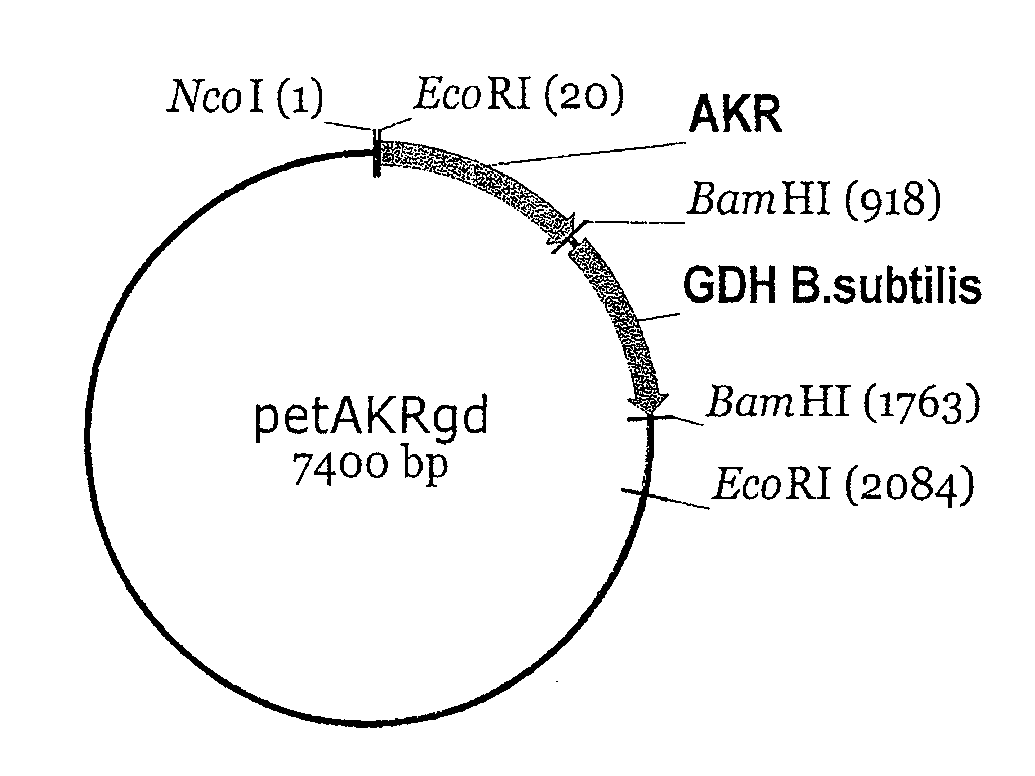Method for the enzymatic production of chiral alcohols
a chiral alcohol and enzymatic technology, applied in the direction of fermentation, etc., can solve the problems of low economic efficiency, difficult production of compound compounds by classical chemical methods, biotransformation processes, etc., and achieve the effect of efficient and inexpensive production of chiral secondary alcohols
- Summary
- Abstract
- Description
- Claims
- Application Information
AI Technical Summary
Benefits of technology
Problems solved by technology
Method used
Image
Examples
1st example
Production of Carbonyl Reductases by Fermentation
[0060]The enzyme LB-ADH, its gene and the recombinant production of LB-ADH in E. coli are disclosed in EP796914. The plasmid pADH-1 transformed into E. coli is used and disclosed in EP796914. Alternatively, the enzyme can be obtained commercially from Jülich Chiral Solutions GmbH as crude extract produced from recombinant E. coli.
[0061]The enzyme T-ADH, its gene and the recombinant production of T-ADH in E. coli are disclosed in DE 102004029112 A1. The plasmid pET24a [ADH-TS] transformed into E. coli is used and disclosed in DE 102004029112 A1. Alternatively, the enzyme can be obtained commercially from Jülich Chiral Solutions GmbH as a crude extract produced from recombinant E. coli.
[0062]The enzyme AKR from baker's yeast is disclosed in the publicly accessible GenBank gene data bank under access number X80642 (gene name YPR1) and can be isolated according to the prior art from genomic DNA of baker's yeast. The GDH mutant GDBS-E96A...
2nd example
Production of methyl (R)-3-hydroxybutyrate from methyl acetoacetate by Biotransformation Using LB-ADH Cells
[0078]1st batch: The reaction batch is composed of 20 L (20.4 kg) of methyl acetoacetate (AcMe), 20 L (15.7 kg) of isopropanol, 1 kg of Celite®, 3 L of LB-ADH cells (fermenter broth as described in the 1st example), 50 μM NADP and 7 L of KPi buffer. The composition of KPi buffer is 0.1 M potassium phosphate, pH 7.0, 0.1 M NaCl, 1 mM MgCl2. The reaction batch is stirred at 30° C. in a 100 L reaction vessel. At various time points, 0.1 ml samples of the reaction batch are taken, extracted with 1 ml of MTBE and analyzed by chiral GC. After 24 hours, the batch is filtered by pressure filtration through a steel vacuum filter from Seitz. In the filtrate the reaction conversion rate of the AcMe used is 94.4%. The enantiomeric excess ee of the product methyl (R)-3-hydroxybutyrate is 100%. The Celite®-enzyme filter cake is returned to the reaction vessel for the 2nd batch.
[0079]The reac...
3rd example
Production of (R)-1-acetoxy-2-propanol from acetoxy-acetone by Biotransformation with LB-ADH Cells
[0088]1st batch: The reaction batch is composed of 20 L (41.5 kg) of acetoxyacetone, 20 L (15.7 kg) of isopropanol, 1 kg of Celite®, 10 L of LB-ADH cells, 50 μM NADP and 1 L of KPi buffer. The composition of KPi buffer is 0.1 M potassium phosphate, pH 7.0, 0.1 M NaCl, 1 mM MgCl2. The reaction batch is stirred at 30° C. At various time points, 0.1 ml samples of the reaction batch are taken, extracted with 1 ml of MTBE and analyzed by chiral GC. After 24 hours, the batch is filtered (see 2nd example). In the filtrate the reaction conversion rate of the acetoxyacetone used is 93.9%. The enantiomeric excess ee of the product (R)-1-acetoxy-2-propanol is 100%.
[0089]The reaction is analyzed by chiral GC, as disclosed in Co10503, with use being made of a gas chromatograph 6890N from Agilent, equipped with a CP-Chirasil-Dex-CB column from Varian (25 m×0.25 mm) for the chiral separation.
[0090]For...
PUM
 Login to View More
Login to View More Abstract
Description
Claims
Application Information
 Login to View More
Login to View More - R&D
- Intellectual Property
- Life Sciences
- Materials
- Tech Scout
- Unparalleled Data Quality
- Higher Quality Content
- 60% Fewer Hallucinations
Browse by: Latest US Patents, China's latest patents, Technical Efficacy Thesaurus, Application Domain, Technology Topic, Popular Technical Reports.
© 2025 PatSnap. All rights reserved.Legal|Privacy policy|Modern Slavery Act Transparency Statement|Sitemap|About US| Contact US: help@patsnap.com



